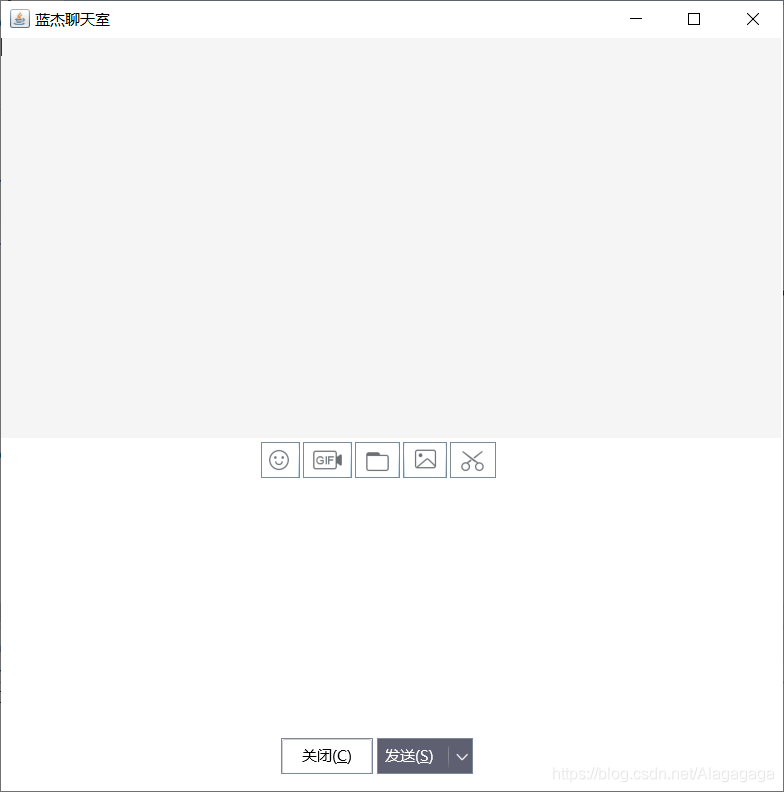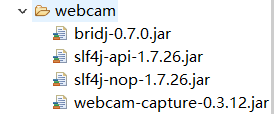网络聊天室
JAVA的学习也进入到了网络这一块,下面手撸一个网络聊天室
先放效果图吸引一下大家




ChatServer类
这里我们用ServerSocket创建服务器,输入我们的端口,建议端口大于2000,2000以内都被大多数软件占用,8888 6666 9090这些数字我都挺喜欢用的,然后用Socket创建一个客户端,这里为了我们达到聊天室的效果,所以我们把每一个客户端都当作一个线程来处理,这样就可以防止阻塞
//启动服务器,主程序
public class ChatServer {
// 主函数
public static void main(String[] args) {
ChatServer cs = new ChatServer();
cs.setupServer(9090);
}
// 在指定的端口上启动服务器
public void setupServer(int port) {
try {
ServerSocket sc = new ServerSocket(port);
System.out.println("服务器创建成功:" + port);
while (true) {
java.net.Socket client = sc.accept();// 等待连接进入
System.out.println("进入了一个客户机连接: " + client.getRemoteSocketAddress().toString());
// 启动一个处理线程,去处理这个连接对象
ServerThread ct = new ServerThread(client);
ct.start();
}
} catch (Exception ef) {
ef.printStackTrace();
}
}
}
ServerThread类
这里就是我们的线程客户端类,我们把客户端的方法在这个线程类里封装好,然后在前面的服务器里创建对象,丢进线程里启动就完事了。
public class ServerThread extends Thread {
private Socket client;// 线程中处理的客户对象
private OutputStream ous;// 输出流对象
private InputStream ins;
private UserInfo user; // 这个线程处理对像代表的用户的信息
// 构造器,创建时必须传入一个Socket对象,
public ServerThread(Socket client) {
this.client = client;
}
// 取得这个线程对象代表的用户对象;
public UserInfo getOwerUser() {
return this.user;
}
public void run() {// 线程中执行的方法
processSocket();
}
// 封装方法,将一条消息发送给这个线程对象所代表的客户机, 传入前,不需要加上\r\n,
public void sendMsg2Me(String msg) {
try {
msg += "\r\n";
ous.write(msg.getBytes());
ous.flush();
} catch (Exception ef) {
}
}
// 封装方法,读取客户机发来的消息
private void processSocket() {
try {
ins = client.getInputStream();
ous = client.getOutputStream();
// 将输入流ins封装为可以读取一行字符串,也就是以\r\n结尾的字符串
BufferedReader brd = new BufferedReader(new InputStreamReader(ins));
sendMsg2Me("欢迎你来聊天!请输入你的用户名:");
String userName = brd.readLine();
sendMsg2Me(userName + ",请输入你的密码:");
String pwd = brd.readLine();
user = new UserInfo();
user.setName(userName);
user.setPwd(pwd);
// 调用数据库模块,验证用户是否存在
boolean loginState = DaoTools.checkLogin(user);
if (!loginState) {// 不存在这个用户账号则关闭
this.closeMe();
return;
}
ChatTools.addClient(this); // 认证成功:将这个对象加入服务器队列
String input = brd.readLine();// 一行一行的读取客户机发来的消息
while (!"bye".equals(input)) {// 一直读取
System.out.println("服务器收到的是: " + input);
// 读到一条消息后,就发送给其他的客户机去...
ChatTools.castMsg(this.user, input);
input = brd.readLine();// 读取下一条
}
} catch (Exception ef) {
ef.printStackTrace();
}
ChatTools.castMsg(this.user, "我下线了,再见!");
this.closeMe();
// 调用服务器管理方法,通知这人下线了
// ChatTools.removeClient(this.user);//暂未实现
}
// 关闭这个线程处理对象
public void closeMe() {
try {
client.close();
} catch (Exception ef) {
ef.printStackTrace();
}
}
}
NetClient类
解释一下这个类的用法,可能有人会问为什么有了上面的ServerThread类为什么还要再创建这个类,我们知道,我们的聊天过程实际上是客户机把消息转化成字节,然后用输出流发送给服务器,服务器用输入流接收,然后服务器再把消息转化成字节,通过输出输入流发给其他客户机。ServerThread类做的是创建客户机线程,以及把消息发送给服务器。而NetClient类则是服务器把消息转发出去的工作,当然你可能会问为什么不把两个功能放在一起,解释起来就是分开来清楚好看,我喜欢,想放在一起我也不拦你!
/**
* 简单命令行客户端实现: 登录服务器,从命令行读取用户输入发送给服务器
*
* @author 帝国
*/
public class NetClient extends Thread {
private String serverIp;// 服务器IP
private int port;// 服务器端口
private OutputStream ous;// 到服务器的输出流对象
private BufferedReader brd;// 到服务器的输入流对象
private Socket client;
// 显示接收到的消息组件,要从界面上传过来
private JTextArea jta_recive;
private boolean flag = true;// 提供标识位
Graphics g;
// 构造器,创建客户机对象时,传入服务器IP和端口和显示组件
public NetClient(String serverIp, int port, JTextArea jta_recive) {
this.serverIp = serverIp;
this.port = port;
this.jta_recive = jta_recive;
}
// 1、连接上服务器,是否连接成功
public boolean conn2Server() {
try {
// 创建一个到服务器端的Socket对象
client = new Socket(this.serverIp, this.port);
InputStream ins = client.getInputStream();// 得到输入输出流对象
// 可以读取一行字符串,也就是以\r\n结尾的字符串
brd = new BufferedReader(new InputStreamReader(ins));
ous = client.getOutputStream();
return true;
} catch (Exception ef) {
ef.printStackTrace();
}
return false;
}
/**
* 2.登录服务器
*
* @param name:用户名
* @param pwd:密码
* @return: 是否登录成功
*/
public boolean loginServer(String name, String pwd) {
try {
// 1.读取服务器发来的一条消息
String input = brd.readLine();
System.out.println("服务器说: " + input);
// 2.按照服务器流程,发送用户名和密码
name += "\r\n";// 发送时字符串后面必须跟上\r\n !!!
ous.write(name.getBytes());
ous.flush();
System.out.println("客户机已将用户名发送,等服务器回应");
input = brd.readLine();
System.out.println("服务器说: " + input);
pwd += "\r\n";
ous.write(pwd.getBytes());
ous.flush();
return true;
} catch (Exception ef) {
ef.printStackTrace();
}
return false;
}
public boolean isFlag() {
return flag;
}
public void setFlag(boolean flag) {
this.flag = flag;
}
// 3、线程中读取服务器发来的消息
public void run() {
while (flag) {
readFromServer();
}
}
// 4、从服务器读取消息,这个方法会阻塞,必须在独立线程中
public void readFromServer() {
try {
String input = brd.readLine();
System.out.println(input);
jta_recive.append(input + "\r\n");// 将收到的消息显示到界面上
} catch (Exception ef) {
ef.printStackTrace();
}
}
/** 发送一条消息到服务器的方法 */
public void sendMsg(String msg) {
try {
msg += "\r\n";
this.ous.write(msg.getBytes());
this.ous.flush();
} catch (Exception ef) {
ef.printStackTrace();
}
}
}
这里我们注意到上面用到了三个类,分别是ChatTools、DaoTools和UserInfo,解释一下,这里是我的两个工具类,一个用来保存我线程队列对象,一个用来保存账号密码
ChatTools类
/**
* @author ZBZ
*这个类是服务器用的,保存了每一个客户机的线程对象,
*并且把它们发来的消息转发出去,发到公屏上,前面只需要再加上每个客户机的id即可,
*这才是网络聊天室的真相。
*/
public class ChatTools {
// 保存处理线程的队列对象
private static ArrayList<ServerThread> stList = new ArrayList();
// 不需要在外部创建此类的对象,所以构造器访问限定符写为private
private ChatTools() {
}
public static void addClient(ServerThread ct) {
// 通知己在线用户,有人上线了:
castMsg(ct.getOwerUser(), "我上线啦!目前人数" + stList.size());
stList.add(ct);// 将这个处理线程对象加入到队列中
}
//解释一下这个方法,因为我们每个客户机发送消息是发送给服务器的,其他的客户机是看不到的,我们看到的,是从服务器接收后再转发出来的消息
public static void castMsg(UserInfo sender, String msg) {
msg = sender.getName() + "说:" + msg;
for (int i = 0; i < stList.size(); i++) {
ServerThread st = stList.get(i);
// ServerThread类中定义有一个将消息发送出去的方法
st.sendMsg2Me(msg);// 发消息给每一个客户机
}
}
}
DaoTools类
/**
* @author ZBZ
*创建用户名和密码以及认证
*/
public class DaoTools {
public static boolean checkLogin(UserInfo user) {
// 在此只验证用户名是否存在
if (userDB.containsKey(user.getName())) {
return true;
}
System.out.println("认证失败!: " + user.getName());
return false;
}
// 内存用户信息数据库
private static Map<String, UserInfo> userDB = new HashMap();
// 静态块:模拟生成内存中的用户数据,用户名为user1~10
// 当程序启动时,这段代码(静态块中的)会自动执行,向userDB中存放数据
static {
for (int i = 0; i < 10; i++) {
UserInfo user = new UserInfo();
user.setName("user" + i);
user.setPwd("pwd" + i);
userDB.put(user.getName(), user);
}
}
}
UserInfo类
名副其实工具类,全是set get 方法,也是为了完整的封装性。
public class UserInfo {
private String name;// 用户名
private String pwd;// 密码
private String loginTime;// 上线时间
private String addres;// 客户端地址
public String getAddres() {
return addres;
}
public void setAddres(String addres) {
this.addres = addres;
}
public String getLoginTime() {
return loginTime;
}
public void setLoginTime(String loginTime) {
this.loginTime = loginTime;
}
public String getPwd() {
return pwd;
}
public void setPwd(String pwd) {
this.pwd = pwd;
}
public String getName() {
return name;
}
public void setName(String name) {
this.name = name;
}
}
有了以上,我们的网络聊天室的基础就完成了,接下来就是我们的界面了
MainNetUI类
可能会有人说,哎你的界面怎么做的,其实很简单,打开QQ截图就完事了,然后把图片加载到按钮上,调一下位置大小就完事了,下面我也会放图,仅供学习使用,tx爸爸不要抓我!如有侵权,联系我立即删!十分抱歉!
public class MainNetUI extends JFrame {
private JFrame jf;// 聊天主界面
private JTextField userName; // 登录界面上的用户名,密码输入框
private JPasswordField psd;
private JTextArea input = new JTextArea(); // 显示接收到的消息组件
private NetClient conn; // 界面所要使用到的连接对象
Image LOGINPICTURE = new ImageIcon("UI1.png").getImage();
ImageIcon login = new ImageIcon("login.png");
// 主函数
public static void main(String[] args) {
MainNetUI qu = new MainNetUI();
qu.showLoginUI();
}
// 显示登录界面:
public void showLoginUI() {
// 设置窗体
setSize(540, 380);
setTitle("蓝杰聊天室");
setDefaultCloseOperation(JFrame.EXIT_ON_CLOSE);
setLocationRelativeTo(null);
// 设置账号框
userName = new JTextField(12);
userName.setBounds(138, 120, 250, 40);
add(userName);
// 设置密码框
psd = new JPasswordField(12);
psd.setBounds(138, 165, 250, 40);
psd.setText("请输入密码");
add(psd);
// 设置按钮
JButton btn = new JButton("登陆", login);
btn.setBounds(118, 254, 284, 46);
this.add(btn);
// 创建监听器
btn.addActionListener(new ActionListener() {
public void actionPerformed(ActionEvent e) {
loginAction();
}
});
setLayout(null);
// 设置窗体可见
setVisible(true);
}
public void paint(Graphics g) {
super.paint(g);
g.drawImage(LOGINPICTURE, 0, 0, null);
}
// 登录事件处理
private void loginAction() {
//这个方法是打开文件选择器的,用于实现文件传输功能,容易做到,但是我懒得做了,有兴趣的同学可以做。
// JFileChooser jfileChooser = new JFileChooser();
// jfileChooser.showOpenDialog(null);
// File file = jfileChooser.getSelectedFile();
// if(file == null) {
// return;
// }
String name = userName.getText();
String word = psd.getText();
// 1.创建连接对象
conn = new NetClient("localhost", 9090, input);
// 2.连接上服务器
if (conn.conn2Server()) {// 如果能连接上服务器
// 3.登录
if (conn.loginServer(name, word)) {
// 4.显示聊天主界面 //登录成功了,要关掉登录界面
showMainUI();
// 5.启动接收线程
dispose();// 关闭登录界面
conn.start();
}
} else {
JOptionPane.showMessageDialog(null, "登陆失败",
"登陆失败", JOptionPane.INFORMATION_MESSAGE);
System.out.println("登录失败!");
}
}
// 显示聊天界面
public void showMainUI() {
jf = new JFrame("聊天客户端v0.1");
jf.setSize(new Dimension(800, 800));
jf.setLocationRelativeTo(null);
jf.setDefaultCloseOperation(JFrame.EXIT_ON_CLOSE);
jf.setLayout(null);
jf.setTitle("蓝杰聊天室");
jf.getContentPane().setBackground(Color.WHITE);
Graphics g =this.getGraphics();
// 发送消息输入区
final JTextArea output = new JTextArea();
// 发送按钮
// javax.swing.JButton bu_send = new javax.swing.JButton("send");
// 聊天室内容
output.setBackground(Color.WHITE);
output.setBounds(0, 444, 780, 200);
input.setBackground(new Color(245, 245, 245));
input.setBounds(0, 0, 780, 400);
// 添加按钮图片
ImageIcon emoji = new ImageIcon("emoji.png");
ImageIcon gif = new ImageIcon("gif.png");
ImageIcon file = new ImageIcon("file.png");
ImageIcon image = new ImageIcon("image.png");
ImageIcon screen = new ImageIcon("screen.png");
ImageIcon close = new ImageIcon("close.png");
ImageIcon send = new ImageIcon("send.png");
JButton bu_emoji = new JButton(emoji);
JButton bu_gif = new JButton(gif);
JButton bu_file = new JButton(file);
JButton bu_image = new JButton(image);
JButton bu_screen = new JButton(screen);
JButton bu_close = new JButton(close);
JButton bu_send = new JButton(send);
bu_emoji.setBounds(260, 404, 39, 36);
bu_gif.setBounds(302, 404, 49, 36);
bu_file.setBounds(354, 404, 45, 36);
bu_image.setBounds(402, 404, 44, 36);
bu_screen.setBounds(449, 404, 46, 36);
bu_close.setBounds(280, 700, 92, 36);
bu_send.setBounds(376, 700, 96, 36);
// 添加监听器
ActionListener listener = new ActionListener() {
@Override
public void actionPerformed(ActionEvent e) {
if(e.getSource()==bu_send) {
String msg = output.getText();
conn.sendMsg(msg);
output.setText(null);
}
else if(e.getSource()==bu_gif) {
System.out.println("sss");
new Thread(new videoSet("localhost", 9090)).start();
}
else if(e.getSource()==bu_close) {
jf.dispose();
conn.setFlag(false);
System.out.println(conn.isFlag());
}
}
};
bu_send.addActionListener(listener);
bu_close.addActionListener(listener);
bu_gif.addActionListener(listener);
jf.add(input);
jf.add(bu_emoji);
jf.add(bu_gif);
jf.add(bu_file);
jf.add(bu_image);
jf.add(bu_screen);
jf.add(output);
jf.add(bu_close);
jf.add(bu_send);
jf.setVisible(true);
}
}









以上就是我们的聊天室大部分功能了,还有视频功能,代码我也会贴,不过要额外导入包,java本身自带的包是不行的,额外导入包的方法我在上一篇Quartz里有介绍过,这里就不赘述,说一下视频的实现,通过那个包调用摄像头,摄像头拍到的画面就是一张图片,然后用输入输出流发送出去即可,把这些封装成一个方法,然后通过一个按钮调用就行
因为要实现一边视频一边聊天,所以视频方法也用线程跑,这样就不会在视频的时候卡住。
用到的包是webcam,这个百度一下就有得下载,然后导入即可,实在不会也可以看看其他博主的使用介绍,我就懒得出教程了,蛮简单的。(干脆还是出一下吧,几分钟的事,那就看我的下篇文章)

public class videoSet implements Runnable {
Graphics g;
private Socket client;
private String serverIp;// 服务器IP
private int port;// 服务器端口
@Override
public void run() {
try {
video();
} catch (IOException e) {
// TODO Auto-generated catch block
e.printStackTrace();
}
}
public videoSet(String serverIp, int port) {
super();
this.serverIp = serverIp;
this.port = port;
}
public void video() throws IOException {
JFrame jf = new JFrame();
jf.setTitle("视频");
jf.setSize(800, 800);
jf.setLocationRelativeTo(null);
jf.setVisible(true);
g = jf.getGraphics();
Webcam web = Webcam.getDefault();
web.setViewSize(WebcamResolution.VGA.getSize());
web.open();
System.out.println("连接成功");
client = new Socket(serverIp, port);
while (true) {
BufferedImage img = web.getImage();
g.drawImage(img, 0, 0, null);
ByteArrayOutputStream baos = new ByteArrayOutputStream();
try {
OutputStream ous = client.getOutputStream();
DataOutputStream dous = new DataOutputStream(ous);
dous.writeInt(baos.size());
baos.writeTo(ous);
} catch (IOException e) {
// TODO Auto-generated catch block
e.printStackTrace();
}
}
}
// 接收对方的视频图像
public void DrawCapture(byte[] buffer) {
ByteArrayInputStream bais = new ByteArrayInputStream(buffer);
try {
BufferedImage show = ImageIO.read(bais);
g.drawImage(show, 100, 100, null);
} catch (Exception ef) {
ef.printStackTrace();
}
}
}
然后我们的网络聊天室就这样完成了!很简单,其实还有很多想实现的功能,比如发送表情,比如私聊,比如截屏,等等,但是这些功能说难也不难,都只是之前知识的应用而已,我就不想花过多精力了,我已经马不停蹄地奔向下一个知识了,时间不等人!望大家也加油!
over~





















 996
996











 被折叠的 条评论
为什么被折叠?
被折叠的 条评论
为什么被折叠?








